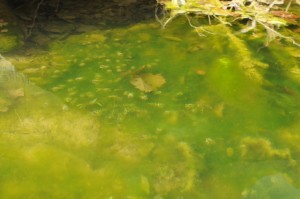It sounds like something kids would say to gross each other out: snot-grass. But to Shenandoah Riverkeeper Jeff Kelble and others who use the river, it’s serious business. For the past 10 years, according to Kelble’s group, long strips of slimy green algae (reminiscent of certain substances known to emanate from human nostrils) have formed in the all major branches of the Shenandoah each year and stuck around long into the colder months – at times remaining throughout the entire year.

Like the toxic algae that poisoned Toledo’s drinking water this summer and the blooms that cause dead zones in the Chesapeake and Gulf of Mexico each year, this algae thrives on excess nutrients running into the water from surrounding land. Suburban development and septic tanks contribute. But water testing throughout the river system shows that the largest source of these excess nutrients is cattle and the manure that farmers spread as fertilizer on their fields. Manure contains nitrogen and phosphorus and, according to Kelble, when applied early in the growing season can easily wash off fields and into waterways. Once in the river, those nutrients feed algae for months, generating thick mats that coat the bottom and obliterate other river life in those stretches.
“It smells like slimy broccoli,” says Kelble. “People think its sewage. It gets on their skin and clothes. It affects recreation on the river.” And that, he says, is a violation of the Clean Water Act.
Since 2010, the non-profit Shenandoah Riverkeeper has requested that Virginia’s Department of Environmental Quality (DEQ) designate all reaches of the Shenandoah River as Impaired. To support their case, the Riverkeeper collected hundreds of letters from disgusted river users describing how the algae has disrupted their paddling, fishing and swimming. But for four years, DEQ has failed to act and the federal Environmental Protection Agency (EPA), which oversees implementation of the Clean Water Act, has failed to take action against them.
So Kelble is taking the next step: Last month, the Shenandoah Riverkeeper informed EPA that it will sue the agency for not upholding the Clean Water Act if it doesn’t take action this fall.
In a best case scenario for river-goers, EPA and DEQ would bow to pressure and add all stretches of the North Fork, South Fork and Mainstem Shenandoah River to Virginia’s Impaired Waters List. Once the river is listed, the state would then work with local communities to develop plans for reducing the polluted runoff that feeds its algae. But even then relief likely will take years.
As the old schoolhouse taunt goes “sticks and stones may break my bones, but names will never….” Well actually, in this case, the snotgrass hurts.

